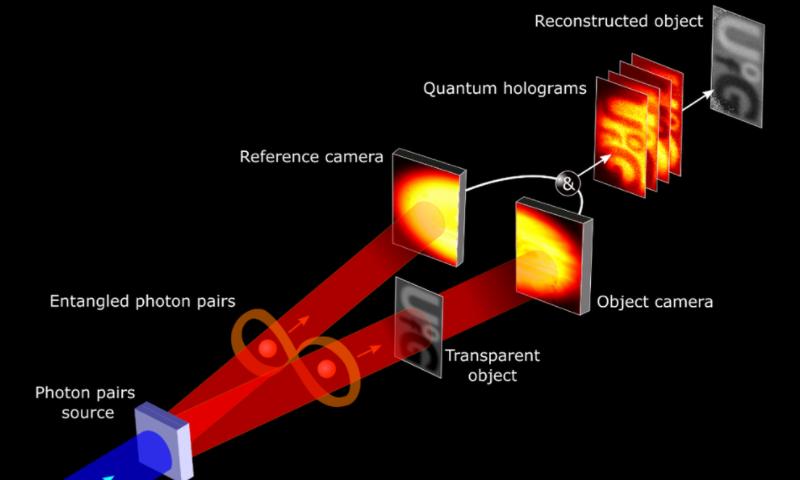
Reporting by XinZhiyuan
EDIT: Time
【Introduction to New Zhiyuan】
This is a novel and amazing find! Or it could spark a new medical revolution, and more recently, quantum mechanics could help generate holograms that scientists don't need to capture any light emitted by objects.
A new study has found that quantum mechanics can help generate holograms without scientists having to capture any light emitted by objects.
This is a novel and surprising discovery that is already being applied in the biomedical field.
Previously, holography was called a "medical revolution", and now, quantum holography may trigger a "new medical revolution".
There is no need to "see" the object
A hologram is one such image – like a 2D window looking at a 3D scene.
Traditional holography is the production of a hologram by scanning an object with a laser beam and encoding its data onto a recording medium, such as film or negatives.
Zhang Yimou's film "One Second" pays tribute to the film era
Holography has been called "a medical revolution" and has important applications in both orthopedics and neurosciences, helping to display images and reconstruct 3D graphics.
Historically, the light sensors used in holograms work best in visible waves, and "the use of mid-infrared light will benefit the biomedical applications of holography." Markus Gr fe, Germany's Institute of Applied Optics and Precision Engineering, said.
Now, with the help of quantum physics, Gr fe and his colleagues have discovered a new way to create holograms of objects without detecting any light they emit.
"The light that illuminates the object is never detected," Gr fe says, and "the light that is detected never interacts with the object."
"Quantum entanglement" helps reconstruct holograms
A key feature of quantum physics is that "superposition" occurs in a "superposition" state of flow, meaning they can essentially be located in two or more places at the same time.
One consequence of quantum physics is "entanglement," where multiple particles are connected together and can immediately interact with each other, no matter how far apart they are.
Then, if a beam of light is illuminated with a "nonlinear crystal", this crystal can split each photon into 2, one with lower energy and the other with a longer wavelength.
In the new study, the researchers used a nonlinear crystal to split a violet laser beam into 2 beams, one of which is far infrared and the other is near infrared.
Next, they shone a sample with a far-infrared beam — a glass plate engraved with a symbol — while they recorded the near-infrared light with a video camera.
With the help of entanglement, the researchers could use data from near-infrared light and reconstruct holograms based on the details of the object scanned by the far-infrared beam.
Traditional holography relies essentially on optical coherence. First, light must interfere to produce a hologram, and second, light must be coherent to interfere.
However, the second part is not entirely true, as certain types of light can be both irrelevant and interfering.
Entangled photons, emitted by quantum sources in the form of a combination of pairs of particles, are intrinsically connected when two particles are entangled together, and even though they may be separated in space, they can effectively act as an object.
From holography, holographic microscopy to quantum holography
01 Holography
In the early 1950s, the Hungarian-British physicist Dennis Gabor invented holography, for which he won the 1971 Nobel Prize in Physics.
Holography is a photographic process that records light scattered by an object and presents it in three dimensions.
Holography records all the information about the amplitude and bitwise phase of the reflected wave of the subject.
02 Holographic microscopy
Holographic microscopy is a kind of image that reproduces the wavelength and wavefront curvature of the reproduced light by changing it, so that the image of the holographic photo is larger than the original, and the magnification rate is up to about 100 times.
In holographic microscopy, scientists use holograms to decipher biological mechanisms in tissues and living cells.
Later, the technique was often used to analyze red blood cells to detect the presence of malaria parasites, as well as to identify sperm cells for the IVF process.
03 Quantum holograms
Quantum holograms can produce extremely detailed images of our bodies and cells.
Quantum holographic technology presents features that are not currently found in holography, improving its accuracy, speed and range.
By implementing multiple holograms for simultaneous measurement, this was not possible before.
"Using the quantum properties of light, illuminating and detecting with different lights, it is possible to achieve imaging and holography." Gr fe said.
Gr fe said, "We can even generate video images."
Resources:
https://spectrum.ieee.org/quantum-holography-using-undetected-light
https://www.sciencealert.com/quantum-holograms-could-make-ridiculously-detailed-images-of-our-bodies-and-cells
https://www.laserfocusworld.com/detectors-imaging/article/14222593/holography-goes-hyperspectral